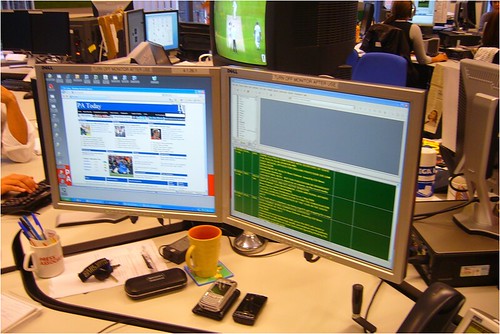Lots of schools with computer suites are getting rid of them by turning them into ordinary classrooms. The reason is that with mobile technology such as tablets, and initiatives like Bring Your Own Device (BYOD), there is no longer any need for a computer suite.
But getting rid of a computer suite is just one option: there are several others.
 The "computer lab" at the Press Association1. Turn it into a classroom
The "computer lab" at the Press Association1. Turn it into a classroom
For the sake of completeness, I include the default option here. If the school is short of space, then turning a computer lab into a classroom is an attractive proposition.
2. Leave it as it is
A computer suite enables you to teach concepts and techniques easily to a whole class, because you know exactly what applications the students are using, which is not always the case with a BYOD programme. This can be especially useful for teaching programming, and also for specialised and/or resource-hungry applications such as desktop-publishing.
3. Leave it as it is, but separated from the rest of the network
In his article in the current edition of Digital Education, Darren Bartlett discusses the options available for making parts of your school network secure so that students can experiment with programming without causing havoc for everyone else!
4. Leave it as it is, with its own network
You can make the computer suite entirely self-contained. Some people may not like this option, because it appears to make life difficult in terms of continuing your work elsewhere in the school. But it’s not insurmountably difficult: you can store files in the cloud, or email them to yourself. And this option does have the advantage of being even more secure in some respects.
5. Keep it for staff only
If you don’t really need the computer suite for students, and are not desperately short of classroom space, then consider making it available for teachers only. This will help to ensure that if teachers need to work on a computer in school they are more likely to be able to and, furthermore, can work on confidential documents more easily. It could also be used for staff training, and also by individual subject departments (in a secondary school) for their departmental meetings. Teachers could also explore and evaluate relevant resources for their subject without the fear of having to make way for a class of kids coming in.
There’s much to be said for having a staff-only area, as I explored in 31 Days to Become a Better Ed Tech Leader -- Day 26: Set Up a Staff-Only Area.
6. Turn it into a satellite of the school library
If you have 15 computers on which students can do research, that’s a pretty good resource – far better, in my opinion, than the usual one or two computers available in a typical school library. Obviously, it is not as convenient as having computers in the school library, and you will need to address staffing, but it seems a shame not to use the computer suite as an electronic research centre.
7. Keep it, but change it
If you have one of those computer suites that consist of rows of computer stations, my advice is to get rid of half of them by giving them to other subject areas, and changing the layout of the room. Bring in a few easy chairs too. I realise that all this may be easier said than done, but making these kind of changes will help to keep the facilities being used, and would make it a great pace to do research for projects or run a computer club.
8. Turn it into an innovation centre
You may need to get rid of a few computers and also change the layout for this option (see the one above). You may even wish to make it into a self-contained network, as suggested earlier. Because a computer suite would be a great place in which to install one-off instances of technology that teachers could try out before adopting them in their own teaching or part of the school.
See also N is for … New Technology: 5 Reasons You Should Buy It.
9. Use it for teaching parents
Use it for teaching parents how to use the applications their children are using. You could also keep it for community use and/or after-school evening classes. This could be a way in which the school could earn some income. Obviously, issues of safeguarding and security would need to be addressed before going down this road, but other schools have done this sort of thing quite successfully.
10. Use it for digital leaders
If you have student digital leaders in your school, you could use the computer suite as a kind of headquarters for them. They could meet, evaluate resources, produce how-to guides and give tyition when needed.
Conclusion
In practice, you could mix and match some of these options. For example, options 5, 8 and 9 would work together, as would 5, 8, 9 and 10 – though in that scenario 5 would not be completely staff-only of course, except for the fact that the room would not be timetabled for lessons.
We are constantly reminded that it's a good idea to prepare students for the "real world", a sentiment with which I wholeheartedly agree. We need to acknowledge, then, that in the real world organisations still use the equivalent of a computer lab. This is very much the case with the Press Association, despite the fact that it makes cutting edge use of mobile technologies.
The key question, as far as I'm concerned, is: what is the most appropriate solution for our particular needs? That may yield a different answer than the question, "What is the current thinking on X?".
Your newsletter editor is hard at work sifting through the submissions for Digital Education, the free newsletter for education professionals. Have you subscribed yet?
Read more about it, and subscribe, on the Newsletter page of the ICT in Education website.
We use a double opt-in system, and you won’t get spammed.


